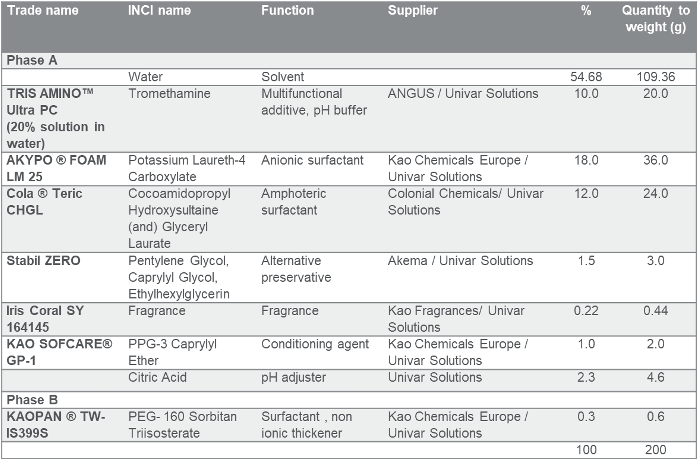
Maxine Junker,
Marketing Specialist EMEA,
Univar Solutions
Shampoo is one of the most basic and widely-used beauty products.
But there are many iterations out there and, from a formula perspective, there is such a plethora of choice of ingredients that it can be overwhelming for the formulator.
Equally, for such a ‘simple’ product the formulation work can be tricky.
Here Maxine Junker, Marketing Specialist EMEA for Univar Solutions, provides a how-to guide to making an eco-friendly shampoo that is mild and easy to formulate.
Shampoos are some of the most basic cosmetic products and everyone has their favorite for various reasons: maybe it’s that heavenly smell, the way the hair feels after use, or the unparalleled creaminess of the foam.
Consumer choices are seemingly endless and navigating all the on-pack claims can make it really difficult to commit to a product.
From a formulation perspective, the task is not any easier. The choice of surfactants, conditioning agents and texturisers that give products their inherent sensorial and performance benefits can be a balancing act for the formulator.
The final product may seem simple, but the formulation work can be tricky.
The first step is the selection of the surfactants. Shampoos, as with cleansing formulations in general, are composed of several surfactants; the main ones are the primary anionics and the amphoterics, which are also known as co-surfactants, or secondary surfactants.
Typically we find the classical duo: sodium laureth sulfate/cocamidopropyl betaine as the stars of the show, but we can now also find various milder surfactant combinations, like carboxylates or alkyl polyglucosides for the anionics, and sultaines for the amphoterics.
Often, the surfactants selection is based on their mildness, their naturality and their physical form.
With the evolution of green chemistry, new ingredients launches contain higher levels of bio-based content, giving us more options whether you want to create a solid or a liquid shampoo.
The right surfactant combination is key for the formula to clean effectively, have good foaming properties, and the right balance of mildness for the hair and the scalp.
The ratio between the different surfactants will impact the transparency, stability and viscosity of the final formula.
To obtain smooth and healthy-looking hair, conditioning agents are your best allies. From the well-known polyquartenium-10 to more high-performance specialties like polyquaternium-67 or polyquarternium-81, the formulator can choose the degree of conditioning and the desired benefits.
Diversity within hair types means hair care products need to respond to different consumer expectations. Shampoos can be designed to provide more shine, heat protection, better curl definition, volume and many more popular on-pack claims.
The last parameter to consider is the texture. Should it be a solid or a liquid? Opaque or transparent? Is the final product mass market or luxury? Is it for the on-the-go consumer, a hotel or at-home use? Considering the end market and final use will help decide which attributes are key.
For liquid formulations, the goal will be to achieve the targeted viscosity and rheology, and for solid products, the use of binders or fillers will be important to ensure homogeneity of the final product.
Every formulator knows how hard it can be to thicken a shampoo with mild surfactants.
The classical solution would be to add salt, however, when using mild surfactants, you often need another strategy like polymers or bio-polymers. Sclerotium gum, for example, provides clarity, viscosity and suspension properties to surfactant systems and it is 100% natural origin and COSMOS approved.
For solid products and shampoo bars, the use of starches like sodium starch octenylsuccinate is a great option if you need a naturally-derived ingredient with binding properties. Multifunctional ingredients are also available and provide both structure and conditioning benefits.
Among the other typical ingredients found in shampoos, the fragrance is an important one. It’s really the final touch that makes the product unique and memorable. It needs to be solubilised directly in the surfactant system or with the help of a solubiliser.
For our latest campaign, Smart Solutions Academy, our technical experts developed an all-in-one shampoo, shower gel and face cleanser.
It’s composed of mild ingredients, demonstrates excellent foaming performance and conditions both your hair and skin while fighting against body odours thanks to a mild multifunctional additive.
The following 3-in-1 cleanser gel formula provides an easy starting point composition for any liquid cleansing and shampoo formulations.
Formulation: 3in1 Cleanser Gel

Procedure (cold process)
1. In the main vessel (400mL beaker), combine water and TRIS AMINO Ultra PC under agitation
2. Add AKYPO FOAM LM 25 under slow agitation (500rpm). As it is a paste, mix until the blend is perfectly homogeneous (20-30min)
3. Add the remaining ingredients of phase A / Cola Teric CHGL, Stabil ZERO, Iris Coral SY 164145 and KAO SOFCARE GP-1 in the order listed under slow agitation (500rpm). Ensure everything is homogeneous between each addition
4. Adjust pH around 7.0 with citric acid
5. Add KAOPAN TW- IS399S to phase A and mix until homogeneous.
Observations & formulation tips
• To achieve the best foaming result in this sulfate-free formula, two complementary surfactants, AKYPO FOAM LM 25 and Cola Teric CHGL, are used in an optimised ratio (3:1 anionic:amphoteric)
• The viscosity is adjusted at the end to facilitate the incorporation of all the previous ingredients.



